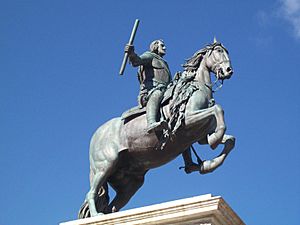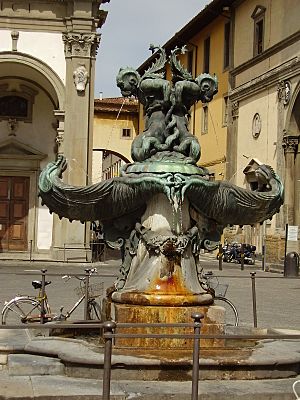Pietro Tacca facts for kids

Pietro Tacca (born September 16, 1577 – died October 26, 1640) was a famous Italian sculptor. He was the main student and follower of another great sculptor, Giambologna. Tacca started his work in a style called Mannerism, which was popular before the Baroque period. Later, he became known for his Baroque style sculptures, which are known for their drama and movement.
Contents
Pietro Tacca's Life and Art
Early Life and Training
Pietro Tacca was born in Carrara, a town in Tuscany, Italy. In 1592, when he was just 15, he joined the workshop of the famous sculptor Giambologna. This was a big opportunity for him to learn from a master.
Taking Over from Giambologna
When Giambologna passed away in 1608, Tacca took over his workshop. He also became the official court sculptor for the powerful Medici family, who were the Grand Dukes of Tuscany. Like his teacher, Tacca made smaller bronze versions of large sculptures. These were popular with art collectors. For example, King Louis XIV of France owned some of Tacca's bronzes.
Finishing Giambologna's Projects
Tacca's first big job was to finish Giambologna's bronze statue of Ferdinando de' Medici on horseback. This statue is in the Piazza della SS. Annunziata in Florence. Tacca had worked on this project from the very beginning. The statue was cast using bronze from cannons taken from enemy ships. These cannons were captured by the Order of Saint Stephen, an order of knights led by Grand Duke Ferdinando I de' Medici.
Famous Public Sculptures
One of Tacca's most famous works for the Medici family is the "Monument of the Four Moors" (1620–1624). This monument is in Livorno, Italy. It shows four figures representing captured pirates at the base of a statue of Ferdinand I de' Medici. This work celebrates the victories of the Medici family. Smaller bronze copies of this monument were made for collectors.
Tacca also created two bronze fountains (around 1629) that were meant for Livorno. However, they were placed in the Piazza della SS. Annunziata in Florence instead. These fountains show a Mannerist style with strange masks and shell-like textures. For Giambologna's equestrian statue of Cosimo de' Medici in the Piazza della Signoria, Tacca added the detailed panels on its base.
The Porcellino
Tacca was inspired by an ancient marble statue of a wild boar. He wanted to create an even better version. The result was the Porcellino (meaning "little pig") in 1612. This bronze statue is in the Mercato Nuovo in Florence. A copy of it can also be found outside Sydney Hospital in Australia.
Sculptures for Other European Rulers
Tacca also created important sculptures for other European rulers:
- For Madrid, Spain, he made Giambologna's bronze statue of Philip III on horseback (1616). This statue was later moved to the Plaza Mayor.
- For Paris, France, he finished Giambologna's equestrian statue of Henry IV (unveiled in 1613). This statue stood on the Pont-Neuf bridge but was destroyed during the French Revolution. A new sculpture replaced it later.
Philip IV's Equestrian Statue
Tacca's last major public project was a huge bronze statue of Philip IV on horseback. This statue was based on a design by the famous painter Diego Velázquez. It was started in 1634 and sent to Madrid in 1640, the year Tacca died. The statue is the main feature of the Royal Palace.
The statue is amazing because the horse is rearing up, and the entire weight of the sculpture balances on its two back legs and its tail. This was a very difficult feat for such a large statue. The famous scientist Galileo Galilei even helped calculate how to make it stable.
Tacca's Legacy
Pietro Tacca's son, Ferdinando Tacca, also worked with him in his studio. After Ferdinando's death, the studio was taken over by another sculptor, Giovanni Battista Foggini.
Works in Museum Collections
- Bargello, Florence: A collection of his small bronze animal sculptures.
- J. Paul Getty Museum: Two small statues of angels holding shields, from 1650–1655.
- Hermitage Museum, St Petersburg: A sculpture called Boy blowing a horn from around 1620.
- Fine Arts Museums of San Francisco: A smaller copy of a "Slave" sculpture from the 18th century.
- National Gallery, Washington DC: Several bronzes believed to be by Pietro Tacca in the Robert H. Smith Collection.
- Liechtenstein Museum, Vienna: A sculpture called Heracles Supporting the World, which was once owned by King Louis XIV.
- Frick Collection, New York: A sculpture called Nessus and Deianira, which is now thought to be by Pietro Tacca, based on a model by Giambologna.
Images for kids
See also
 In Spanish: Pietro Tacca para niños
In Spanish: Pietro Tacca para niños
- Antonio Susini, another artist who worked with Giambologna.




